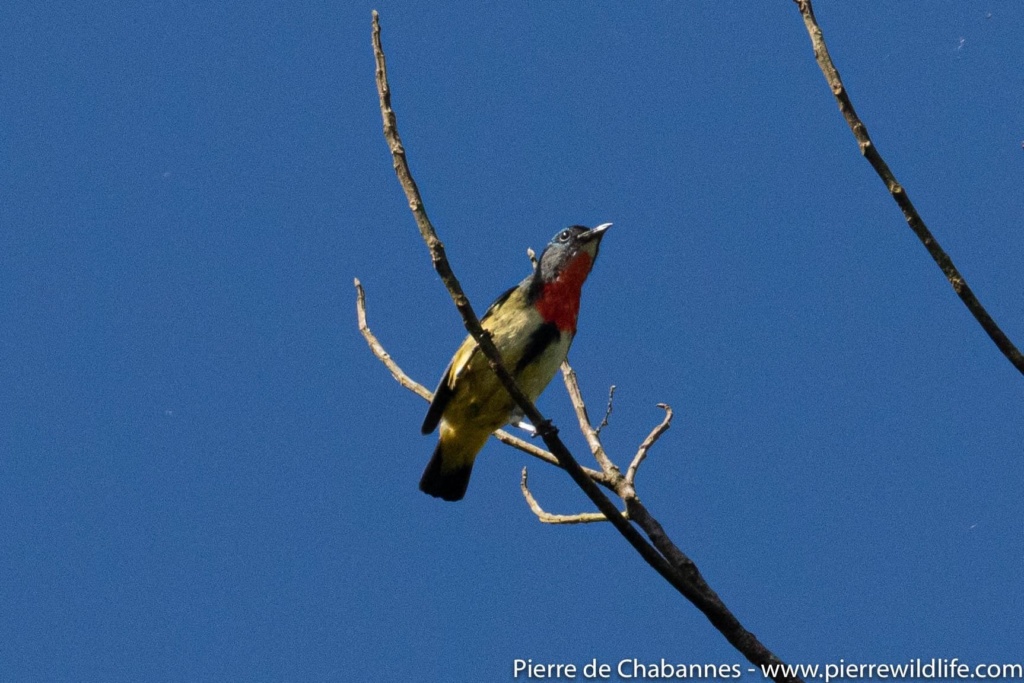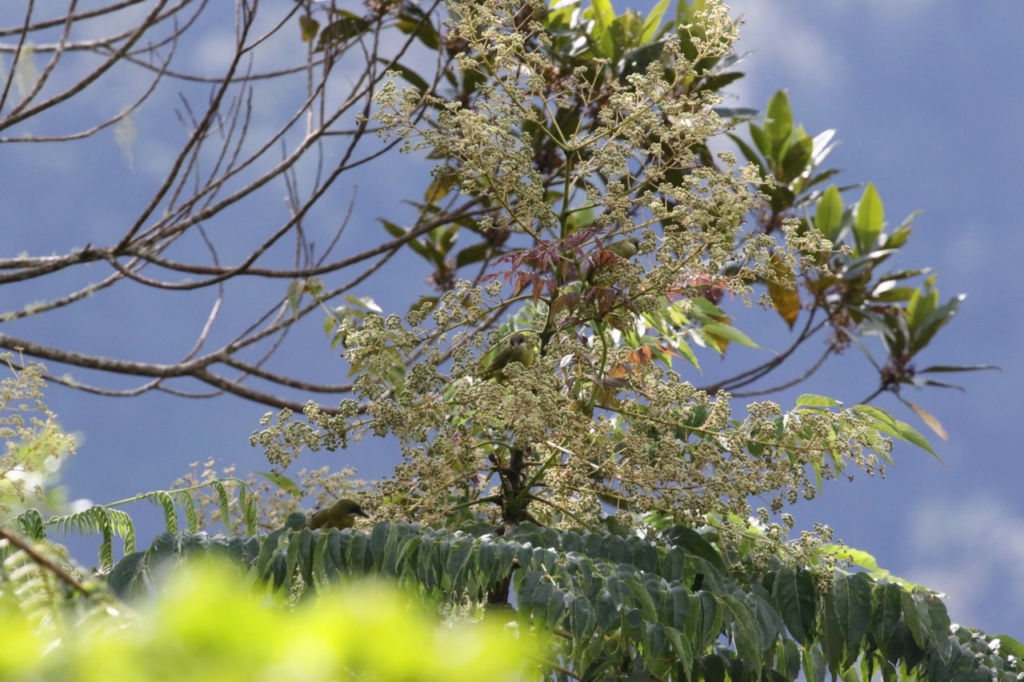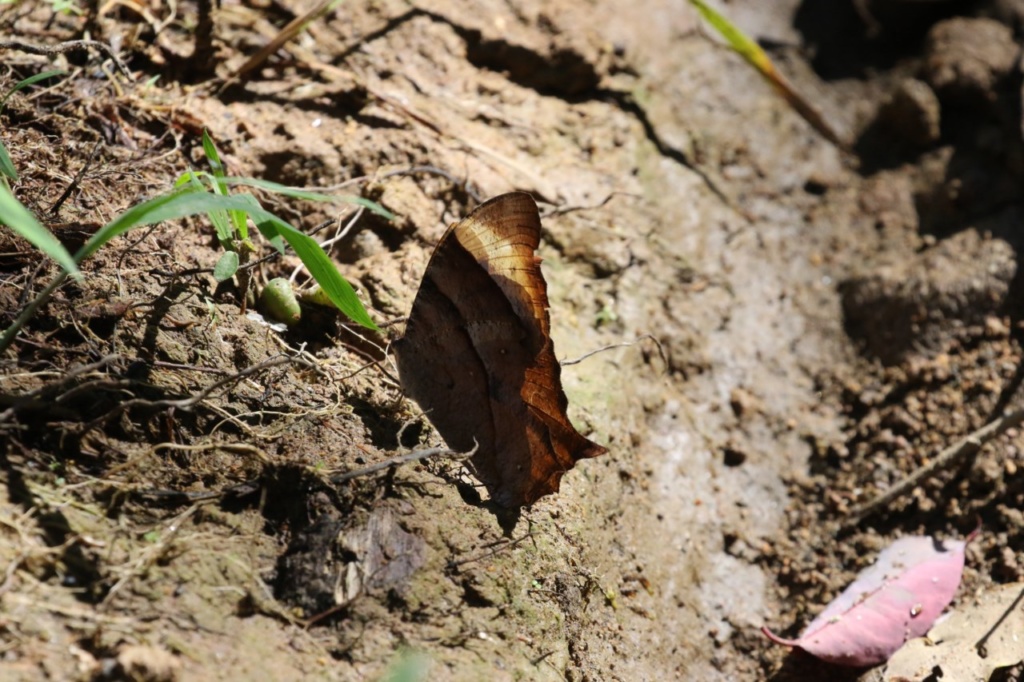Hi everyone,
Mindanao has always been an island of mystery for me until I was finally able to spend enough time there and realize how much I love the place ! Until recently, I have to admit I knew very little about Mindanao’s fauna and, like most, my knowledge was limited to the Mindanao water monitor, the Mindanao bleeding heart, the Mindanao rufous hornbill, Mindanao tarictic and a couple of other wider-ranging species. Little did I know that Mindanao is home to an amazing array of endemic birds but also reptiles, amphibians, insects and mammals are really well represented and mostly understudied. Young scientists like Kier Michael Pitogo are doing amazing work rediscovering species in remote areas and we can expect a lot more from Mindanao in the future ! I am surely looking to take part actively in the field work here !
 The Olive-capped flowerpecker (Dicaeum nigrilore nigrilore) is one of the many species endemic to the mountains of Mindanao. Lots still needs to be done to study the biodiversity of these remote areas.
The Olive-capped flowerpecker (Dicaeum nigrilore nigrilore) is one of the many species endemic to the mountains of Mindanao. Lots still needs to be done to study the biodiversity of these remote areas.
By Christmas 2019, thanks to Sonny and Marco Dizon from Davao Crocodile Park, thanks to my friend Ana Borja and thanks to our guide Benjamin Torregosa Maputi Jr, I had my first opportunity to leave Davao City area and discover more of Mindanao. I got fascinated by the Apo myna and its amazing colors, crest … so I decided to make it my number one target for this birding trip to Mt Kitanglad.
 The sign indicating the entrance to the protected area around Mt Kitanglad.
The sign indicating the entrance to the protected area around Mt Kitanglad.
Located in the northern half of Mindanao, in the province of Bukidnon, Mt Kitanglad is the fourth highest mountain in the Philippines with an altitude of 2899 meters. Mt Kitanglad is well known for being home to one of the last primary rainforests in the country and the diversity of animals occurring there is said to be truly amazing.
 Mt Kitanglad viewed from the forest path.
Mt Kitanglad viewed from the forest path.
But accessing Mt Kitanglad’s birding areas is far from easy. The ride from Davao City takes a good 4 to 5 hours and, once we secured the access by asking permission to the local community’s chief, we still had to climb a very bumpy dirt and rock road through agrigultural fields. Our driver did wonders but finally had to stop as the road was getting too dangerous to drive on so we ended up walking all the way to the forest… or at least what is left of it.

The road to Mt Kitanglad protected area is rough to navigate and goes through logged forests, converted into agricultural land.
The high-altitude forests are still there and look quite healthy but the lower we get, the more deforestation happens for agriculture. The local tribes and communities are aware of the importance of healthy forest and the good it brings (eco-tourism is getting big in Philippines) so what is left of the lower slopes’ forest is being protected at this time. These forests are home to the mighty Philippine eagle (Pithecophaga jefferyi) and we were very lucky to even see this king of the skies taking off and flying above us as we were about to drive back to Davao. I took no photos as my camera gear was in the car already but seeing the eagle in person was enough of a blessing to leave all of us in awe.

Large tracts of forests have been cleared for agriculture on the lower slopes of Mt Kitanglad. In other areas of Mindanao (especially near Bislig, in the east), this is much worse with industrial palm oil plantations.
When I entered the forest, on the slopes of Mt Kitanglad, I was amazed at how cool the atmosphere is, even if we were not that high. The forest is humid but the humidity was far less intense that what I had experienced in places like Raja Sikatuna in Bohol or Mt Kinabalu forests in Borneo. Most of the trees aren’t that big but look very healthy, with lots of epiphytes, lichen, moss… A beautiful sight for us !
 The trees of Mt Kitanglad protected areas were covered with all kinds of mosses, lichens and more !
The trees of Mt Kitanglad protected areas were covered with all kinds of mosses, lichens and more !
I did manage to see the coveted Apo myna (Basilornis mirandus) but never from close. Mt Kitanglad is known to be the best site to watch this species and get really good photos but I guess that was the unlucky part of our trip. We will have more chance with the species next time ! On the other hand, seeing the Philippine eagle fly was extraordinarily lucky so who could complain !
 The Apo myna (Basilornis mirandus) is one of Southeast Asia’s most distinctive starling species. It is classified as Near Threatened on the IUCN Red List.
The Apo myna (Basilornis mirandus) is one of Southeast Asia’s most distinctive starling species. It is classified as Near Threatened on the IUCN Red List.
On the other hand, I got to see an unexpected large number of passerines and that made me re-name my quest from “Apo myna trip” to “Flowerpecker galore” ! We spotted and photographed no less than four species, including two who treated us with really good views ! The pygmy flowerpecker (Dicaeum pygmaeum davao) and the Buzzing flowerpecker (Dicaeum hypoleucum pontifex) remained more hidden than the other two (see photos below) but we could still get relatively good views of them and the food items they prefer.
 The fire-breasted flowerpecker (Dicaeum ignipectus apo) is the most colorful of all local flowerpecker species. It is widespread in montane forests from Negros to Mindanao.
The fire-breasted flowerpecker (Dicaeum ignipectus apo) is the most colorful of all local flowerpecker species. It is widespread in montane forests from Negros to Mindanao.
While looking for birds, our guide Benjamin got my attention on very large pyramidal clumps of small yellow berry-like flowers, telling me that many passerines from the area are feeding on these. It didn’t take long for the first flowerpeckers to appear, quickly followed by the local endemic Mindanao white-eye (Heleia goodfellowi goodfellowi) and by another endemic white-eye : the Mindanao mountain white-eye (Zosterops montanus vulcani).
 These big clumps of yellowish flowers are an important food source for local passerines.
These big clumps of yellowish flowers are an important food source for local passerines.
The cinnamon ibon, one of the highly prized local endemics, remained hidden but we managed to see another very colorful local endemic, the Black-and-cinnamon fantail (Rhipidura nigrocinnamomea nigrocinnamomea). I was used to seeing black and white colors on fantails and had no idea some of them where that colorful ! This single individual, after playing hide and seek for a while, gave us a 10 seconds window for getting really nice open photos. No way I could be thankful enough for such a treat !
 The Black-and-cinnamon fantail (Rhipidura nigrocinnamomea nigrocinnamomea) was one of the biggest surprises of the day.
The Black-and-cinnamon fantail (Rhipidura nigrocinnamomea nigrocinnamomea) was one of the biggest surprises of the day.
The last two birds we saw before leaving (and before the mighty Philippine eagle came out of the forest) were a couple of Philippine hanging-parrots which I couldn’t photograph and a beautiful specimen of Philippine green-pigeon (Treron axillaris canescens) who stayed in the open long enough for me to get a record shot.
 A single Philippine green-pigeon (Treron axillaris canescens) sitting on the top of a lonely tree at the edge of the forest.
A single Philippine green-pigeon (Treron axillaris canescens) sitting on the top of a lonely tree at the edge of the forest.
Strangely enough, we didn’t see any reptile or amphibian at all during our little survey but we managed to photograph a couple of local endemic butterfly subspecies. Of course, the Scarlet mormon (Papilio deiphobus rumanzovia) and Philippine birdwing (Troides rhadamantus rhadamantus) were common as it is in most forests of the southern half of Philippines but other much less common species showed up such as the Schaus’s crow (Euploea blossomae hilongensis), the Boisduval’s evening brown (Melanitis boisduvalia) and the Dannatt’s tiger (Parantica dannatti malinagensis).
 A pair of Dannatt’s tiger (Parantica dannatti malinagensis) near the main path.
A pair of Dannatt’s tiger (Parantica dannatti malinagensis) near the main path.
 Schaus’s crow (Euploea blossomae hilongensis), a species I had never heard of before.
Schaus’s crow (Euploea blossomae hilongensis), a species I had never heard of before.
This expedition is only the first of many to come in the area in order to document many more endemic species and have a better understanding of the biodiversity around the Kitanglad range and Mt Kitanglad in particular.
 Three Mindanao white-eye (Heleia goodfellowi goodfellowi) feeding on flowers.
Three Mindanao white-eye (Heleia goodfellowi goodfellowi) feeding on flowers.
 There are still lots of research that needs to be done on Mindanao fauna. So far, this Boisduval’s evening brown (Melanitis boisduvalia) couldn’t be assigned to a subspecies.
There are still lots of research that needs to be done on Mindanao fauna. So far, this Boisduval’s evening brown (Melanitis boisduvalia) couldn’t be assigned to a subspecies.
Until next time,
Pierre de Chabannes
Founder, ACEE